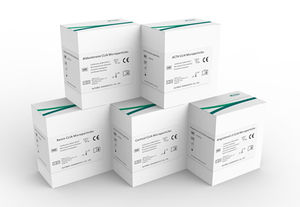
- Laboratory
- Laboratory medicine
- Myocardial infarction test kit
- Autobio Diagnostics
Myocardial infarction test kit CMH0102myoglobinD-dimercTnI
Add to favorites
Compare this product
Characteristics
- Applications
- for myocardial infarction
- Tested parameter
- myoglobin, D-dimer, cTnI, NT-proBNP, calcium, actin
- Sample type
- clinical, blood, plasma, cell
- Sample volume
0.01 ml, 0.02 ml, 0.05 ml
(0.00034 US fl oz, 0.00068 US fl oz, 0.00169 US fl oz)
Description
Myocardial injury markers refer to proteins and / or enzymes released into peripheral blood and detected during myocardial injury. The detection of these substances can provide hints for the clinical diagnosis, condition monitoring and risk stratification of acute myocardial infarction and other diseases with myocardial injury.
The main markers of myocardial injury were troponin T, troponin I, CK-MB and myoglobin. Troponin is composed of three subunits, which have independent structures and different regulatory effects. Cardiac troponin regulates and mediates the interaction between actin and myosin with the participation of calcium ions, so as to maintain the relaxation and contraction of myocardium. When the myocardial cell membrane is intact, cardiac troponin will not penetrate the cell membrane and enter the blood circulation. Only when the myocardial cell membrane is damaged, can troponin be released into the blood. The concentration of troponin in blood circulation is directly proportional to the procedure of myocardial damage. With half-life of up to 15 days, it is the best index for retrospective detection.
Clinical Significance
Quantitative determination of cTnI in human plasma Cardiac troponin I (cTnI) is a contractile protein exclusively present in the cardiac muscle. It is one of three subunits of the troponin complex (I, T, C), which with tropomyosin are bound to actinin the thin filament of the myofibril. Its physiological role is to inhibit the ATPase activity of the Its physiological role is to inhibit the ATPase activity of the actin-myosincomplex in the absence of calcium, and therefore, to prevent muscular contraction.
Catalogs
No catalogs are available for this product.
See all of Autobio Diagnostics‘s catalogsRelated Searches
- Autobio Diagnostics test kit
- Solution reagent kit
- Autobio Diagnostics blood test kit
- Autobio Diagnostics serum test kit
- Plasma assay kit
- Infectious disease detection kit
- Diagnostic reagent kit
- Respiratory infection test kit
- Autobio Diagnostics clinical test kit
- COVID-19 detection kit
- Clinical chemistry analyzer
- Bacteria reagent kit
- Antigen assay kit
- Clinical reagent kit
- IgG test kit
- Automatic clinical chemistry analyzer
- Benchtop clinical chemistry analyzer
- Laboratory detection kit
- Autobio Diagnostics cell test kit
- Microbiology reagent kit
*Prices are pre-tax. They exclude delivery charges and customs duties and do not include additional charges for installation or activation options. Prices are indicative only and may vary by country, with changes to the cost of raw materials and exchange rates.


